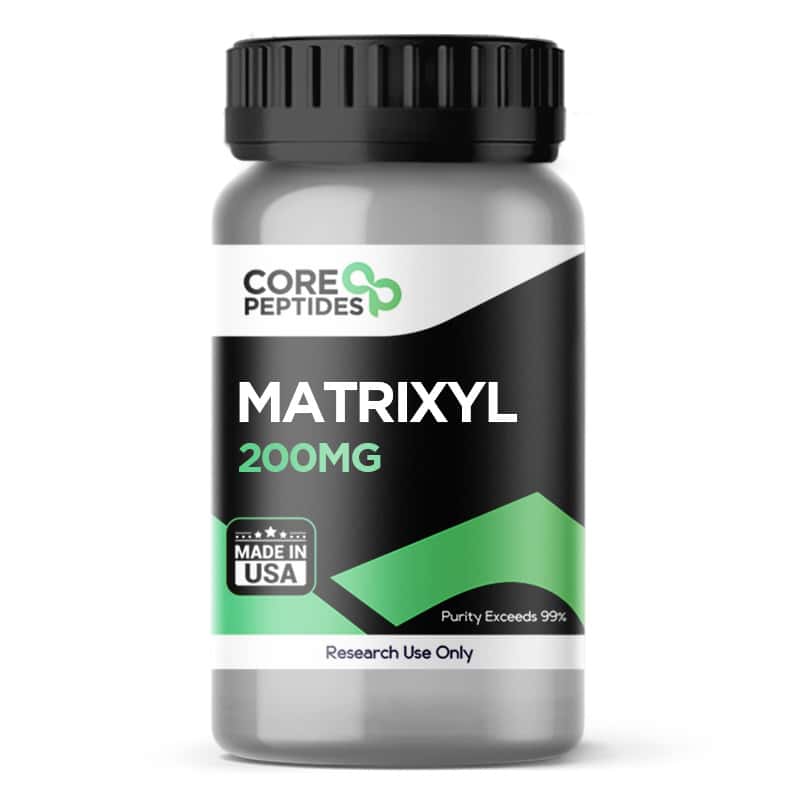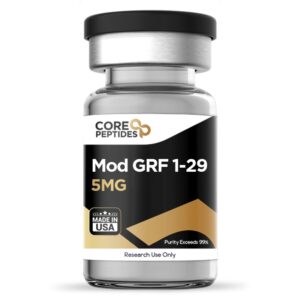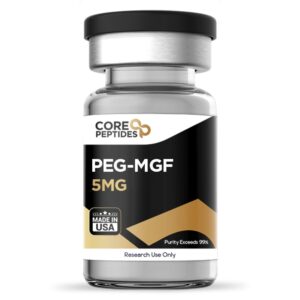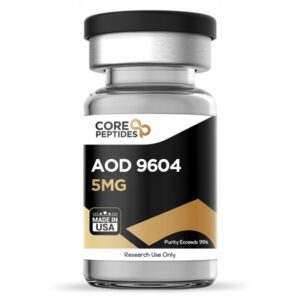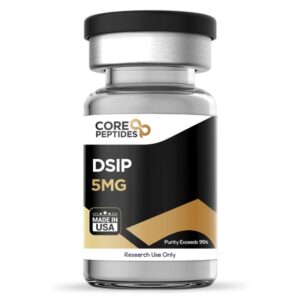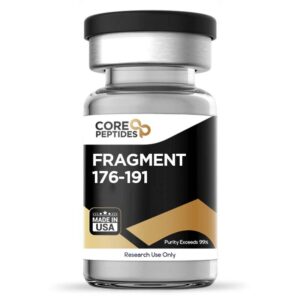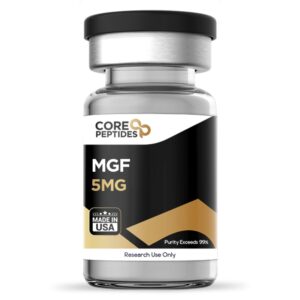Matrixyl (200mg)
$171.00
Size: 200mg
Contents: Matrixyl
Form: Lyophilized powder
Purity: >99%
SKU: P-Matrixyl
FREE Shipping on $200+ orders
Discount per Quantity
| Quantity | Discount | Price |
|---|---|---|
| 5 - 8 | 5% | $162.45 |
| 9 + | 10% | $153.90 |
Matrixyl
Matrixyl, also known as as palmitoyl pentapeptide-4 or palmitoyl pentapeptide-3, is a synthetic peptide currently under scientific investigation for its potential to stimulate collagen production in the skin. It is classified as a matrikine - a messenger peptide that may regulate cell activities by interacting with their specific receptors. Collagen is a protein that is considered to support flexibility and structural integrity in the extracellular matrix of the skin. The conjugation with the palmitoyl introduces the potential for more consistent delivery across the skin and better stability to skin proteases.(1)
Chemical Makeup
Molecular formula: C39H75N7O10
Molecular weight: 802.05 g/mol
Other known titles: Palmitoyl pentapeptide-4, (palmitoyl pentapeptide-3 prior to 2006)
Research and Clinical Studies
Matrixyl Peptide and Collagen Synthesis
Studies suggest that Matrixyl may act as a signal peptide fragment of the C-terminal propeptide of type I collagen.(2) The scientists indicate that it may act by signaling fibroblasts and "stimulates feedback regulation of new collagen synthesis and ECM proteins." Fibroblasts are a type of cell that is found in connective tissue. They play a crucial role in forming and maintaining the extracellular matrix (ECM), a complex network of proteins and carbohydrates that provides structural support to tissues and organs. The main extracellular matrix proteins are collagens, elastins, fibronectins, and laminins. Fibroblasts produce and secrete collagen, the ECM's main structural protein. Collagen provides tensile strength to tissues and organs and is essential for maintaining their shape and integrity. During wound healing, fibroblasts are responsible for depositing new collagen fibers to replace damaged tissue. Researchers suggested that Matrixyl may potentially stimulate collagen production in a concentration-dependent manner close to the critical aggregation concentration, indicating that self-assembly and collagen production are interrelated.(3) Self-assembly of peptides includes hydrogen bonds, electrostatic interactions, hydrophobic interactions, aromatic interactions (π–π stacking), and van der Waals forces.
Matrixyl Peptide and Wrinkles
Several studies suggest some potential for Matrixyl to induce action on fibroblasts and collagen synthesis. One research study examined its potential in research models of bi-lateral exposure to Matrixyl peptide and placebo, respectively.(5) The study reported that the peptide appeared to have reduced overall wrinkle depth compared to the placebo control.
An additional study aimed to investigate the cellular activity of Matrixyl.(6) A compound infused with Matrixyl was introduced twice daily to the periorbital area of the research model for a duration of 8 weeks. The results indicated improvements via the exposure to Matrixyl, which appeared to exhibit better results when compared to other peptides and placebo based on measured data.
Another study aimed to isolate the potential of Matrixyl to improve skin surface texture and wrinkle depth in the periorbital region.(7) Two double-blind, randomized, controlled studies were conducted in research models of moderate to distinct periorbital wrinkles. After 4 weeks, the peptide was reported by researchers to have appeared to reduced the texture of periorbital skin and reduced the apparent depth of larger wrinkles.
Matrixyl Peptide and Scarring
One study investigated the potential of Matrixyl on fibroblast contractility and its potential role in scar formation.(8) Matrixyl was reported to reduce the expression of α-SMA (alpha-smooth muscle actin) and inhibit the trans-differentiation of fibroblasts to myofibroblasts. Scientists indicate alpha smooth muscle actin (α-SMA) is a protein commonly found in smooth muscle cells, including those in blood vessels and hollow organs such as the intestines and bladder. It is also considered to be expressed by a specialized type of cell called a myofibroblast, which plays a key role in wound healing and tissue repair. In the context of fibrotic scarring, the expression of α-SMA by myofibroblasts is associated with the deposition of excess collagen and the development of scar tissue.
Matrixyl Peptide and Tissue Repair
One animal study investigated the potential of Matrixyl in promoting wound healing. Animals were divided into seven groups and monitored for 21 days.(9) Results suggested that Matrixyl may positively impact wound healing, with larger potential seen in the high-concentration Matrixyl groups compared to a positive control group. The scientists reported that "the macroscopic results showed that wound healing was improved from 63.5 up to 81.81% in treatment groups compared to that in the negative control group."
Another article described the development of a novel conjugate of Matrixyl with imidazolium-based ionic liquid.(10) Imidazolium-based ionic liquids have antimicrobial and skin penetration properties. These conjugates also have collagenesis-inducing activity comparable to the proposed efficacy of Matrixyl.
Matrixyl peptide is available for research and laboratory purposes only. Please review and adhere to our Terms and Conditions before ordering.
References:
- Choi, Y. L., Park, E. J., Kim, E., Na, D. H., & Shin, Y. H. (2014). Dermal Stability and In Vitro Skin Permeation of Collagen Pentapeptides (KTTKS and palmitoyl-KTTKS). Biomolecules & therapeutics, 22(4), 321–327. https://doi.org/10.4062/biomolther.2014.053
- Errante, F., Ledwoń, P., Latajka, R., Rovero, P., & Papini, A. M. (2020). Cosmeceutical Peptides in the Framework of Sustainable Wellness Economy. Frontiers in chemistry, 8, 572923. https://doi.org/10.3389/fchem.2020.572923
- Jones, R. R., Castelletto, V., Connon, C. J., & Hamley, I. W. (2013). Collagen stimulating effect of peptide amphiphile C16-KTTKS on human fibroblasts. Molecular pharmaceutics, 10(3), 1063–1069. https://doi.org/10.1021/mp300549d
- Tałałaj, U., Uścinowicz, P., Bruzgo, I., Surażyński, A., Zaręba, I., & Markowska, A. (2019). The Effects of a Novel Series of KTTKS Analogues on Cytotoxicity and Proteolytic Activity. Molecules (Basel, Switzerland), 24(20), 3698. https://doi.org/10.3390/molecules24203698
- Robinson, L. R., Fitzgerald, N. C., Doughty, D. G., Dawes, N. C., Berge, C. A., & Bissett, D. L. (2005). Palmitoyl pentapeptide provides improvement in photoaged human facial skin. International journal of cosmetic science, 27(3), 155–160. https://doi.org/10.1111/j.1467-2494.2005.00261.x
- Aruan, R. R., Hutabarat, H., Widodo, A. A., Firdiyono, M. T. C. C., Wirawanty, C., & Fransiska, L. (2023). Double-blind, Randomized Trial on the Effectiveness of Acetylhexapeptide-3 Cream and Palmitoyl Pentapeptide-4 Cream for Crow's Feet. The Journal of clinical and aesthetic dermatology, 16(2), 37–43.
- Kaczvinsky, J. R., Griffiths, C. E., Schnicker, M. S., & Li, J. (2009). Efficacy of anti-aging products for periorbital wrinkles as measured by 3-D imaging. Journal of cosmetic dermatology, 8(3), 228–233. https://doi.org/10.1111/j.1473-2165.2009.00444.x
- Park H, An E, Cho Lee AR. Effect of Palmitoyl-Pentapeptide (Pal-KTTKS) on Wound Contractile Process in Relation with Connective Tissue Growth Factor and α-Smooth Muscle Actin Expression. Tissue Eng Regen Med. 2017 Jan 19;14(1):73-80. doi: 10.1007/s13770-016-0017-y. PMID: 30603464; PMCID: PMC6171572.
- Kachooeian, M., Mousivand, Z., Sharifikolouei, E., Shirangi, M., Firoozpour, L., Raoufi, M., & Sharifzadeh, M. (2022). Matrixyl Patch vs Matrixyl Cream: A Comparative In Vivo Investigation of Matrixyl (MTI) Effect on Wound Healing. ACS omega, 7(28), 24695–24704. https://doi.org/10.1021/acsomega.2c02592
- Gomes A, Bessa LJ, Fernandes I, Aguiar L, Ferraz R, Monteiro C, Martins MCL, Mateus N, Gameiro P, Teixeira C, Gomes P. Boosting Cosmeceutical Peptides: Coupling Imidazolium-Based Ionic Liquids to Pentapeptide-4 Originates New Leads with Antimicrobial and Collagenesis-Inducing Activities. Microbiol Spectr. 2022 Aug 31;10(4):e0229121. doi: 10.1128/spectrum.02291-21. Epub 2022 Aug 11. PMID: 35950860; PMCID: PMC9431032.
